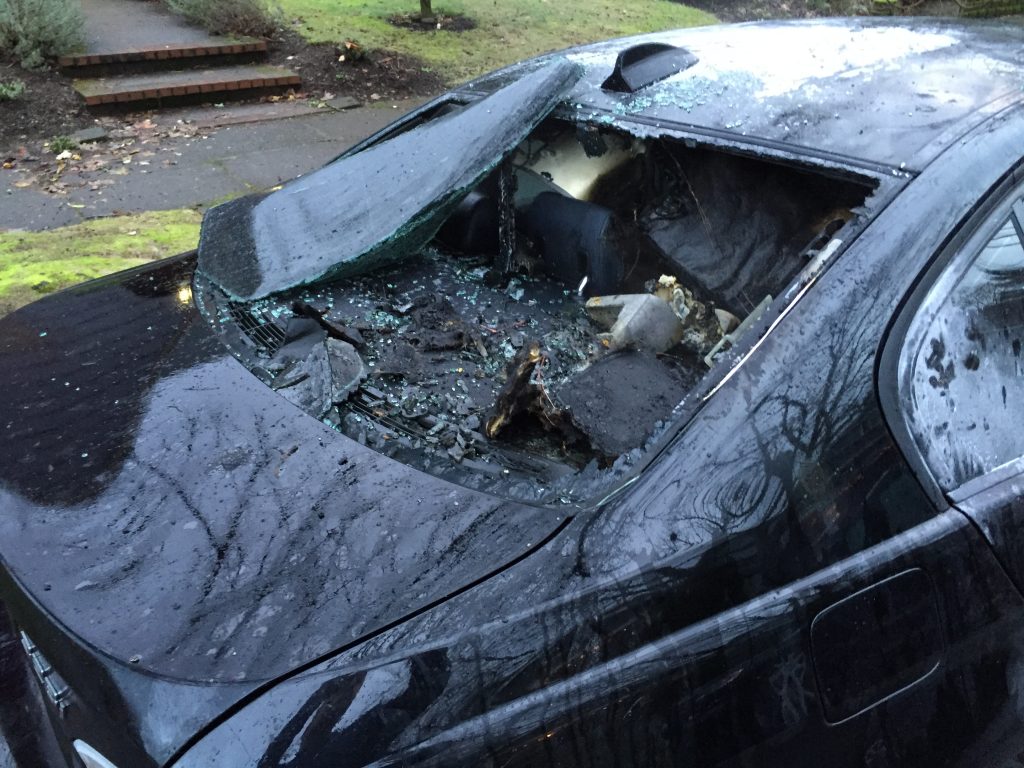On December 22, 2015, a funny thing happened. (Not “funny ha-ha” so much, but more “funny OMG WTF.”). Two years later, I realize the impact it had on my real estate negotiation skills.
My car caught on fire.
It was a cold winter morning, so I went out to the curb where it was parked and turned it on to let it warm up, and to let the rear window defroster do its work. About 2 minutes later, my wife looked out the window and yelled “OMG, your car is on fire!!”
That was a pretty surreal statement, but sure enough, she was right. This is not a situation I’m used to encountering, so it took me a second to get my bearings. A bunch of questions rushed through my mind:
- “Is it going to explode?!”
- “Will it catch the tree on fire?!”
- “Do I need to try to turn the car off?!”
My wife called 911 while I frantically scrambled around looking for a fire extinguisher. I found one, ran out to the car, and emptied the fire extinguisher trying to put the flames out. It was totally futile. Within a few minutes, the fire department came and–with surprising calm–put the fire out. After we got the fire extinguished (thank you firemen!) and the smoke cleared, here’s what we saw:

Totaled.
Bummer. I liked this car. But it looked like it was time to go shopping for a different vehicle.
Rewind 3 Months
The spooky thing is, for the past few months before this happened, I had been thinking of getting a different car, for business purposes. You see, this car that I had been driving was a 2008 BMW 325i. It wasn’t particularly fancy, as far as BMW’s go, but it was a BMW nonetheless, so it has a built-in perceived level of fanciness. A good portion of my work is going to meet property owners (“sellers” as I optimistically call them)–often at their own homes–to engage in a real estate negotiation about the possibility of me buying their property. And truth be told, many times over the prior months, I had felt self conscious about showing up in a BMW. As its owner, I knew it wasn’t an especially fancy or expensive car, but that BMW emblem carries meaning nonetheless…and we all know it. I was getting more and more concerned that this car was sending a message to these property owners that I didn’t want to send. I remember several times parking my car around the corner from the house I was visiting, or behind a big bush, so that they wouldn’t see it.
Understanding Your Brand Story
For about 12 years, I owned and ran a branding agency. We specialized in brand strategy consulting for community banks and credit unions. During this time, I created a branding framework that all of our consulting was based on–and it’s a framework I continue to think on often. In a nutshell:
Branding is a 3-step process:
- Finding the Story
- Telling the Story
- Proving the Story
‘Finding the Story’ is about discovering your authentic brand story and knowing exactly what you stand for. Who are you, really? What do you stand for? What are your values, beliefs and standards?
‘Telling the Story’ is about using words and pictures to convey this authentic brand story. It’s what you put on your website, brochures and business cards to communicate the story you identified in the ‘Finding the Story’ phase.
‘Proving the Story’ is about demonstrating this brand story with your behaviors and actions. This is the most important part. After all, you can say anything you wan to on your website, but it’s how you behave and conduct yourself that really sticks with people. Just like your mom told you when you were 6, “actions speak louder than words.”
To put in the parlance of this branding framework, I was reasonably clear about my brand story (now, 2+ years later, I am VERY clear on this brand story), and I was concerned that this BMW was not Proving the Story effectively. My authentic brand story is one of an approachable, respectable, polite, relatable REGULAR guy–that’s the real me. My brand is based on putting people at ease by quickly demonstrating to them that I am not some fast-talking sharky salesman. Rather, I’m a normal guy with a respectable small business buying rental properties. I was getting very worried that this BMW was silently sending the message that I was a flashy hot shot…an inauthentic message I very much did NOT want to be sending.
Choosing the Car That Proved My Story
Seeing this as an opportunity to select a vehicle (using the insurance company’s money!) that more accurately Proved the Story of the brand I knew was authentic, I set out on a hunt for the perfect car for my brand of real estate negotiation. I felt it needed be somewhat masculine, a little “contractor-y,” a regular mainstream brand, and solid but modest. In other words, I wanted to pull up to the houses of my sellers with a car they could they see themselves driving–because this would reinforce to them that I was “their type of person.” I also wanted them to feel like I had the level of success and financial wherewithal to be able to afford a reasonably nice car, but not so much money that I was a higher roller.
Functionally, of course, I wanted it to meet the needs of my life, which meant it was easy to drive in the city, not too big to get into parking garages and spaces, and was decent for hauling around my wife, dog and gear, and going up into the mountains. I wanted it to be new enough that I wouldn’t have too many mechanical issues, and I wanted it to be affordable.
I quickly zeroed in on the Toyota 4Runner as a great candidate, and began taking a look at the options. This only brought up another critical question: Which model year was right? In the last 15 years, the 4Runner had been slightly redesigned at least 3-4 times, so there was a lot of variety of looks. Something too new could send the message of extravagance–after all, brand new 4Runners are not inexpensive cars. On the other hand, something too old could send the message that I don’t have the money or level of success needed to buy a property. I needed just the right balance for my brand of real estate negotiation.
After much consideration and obsessive micro-analysis of each model year and the options available for sale in my city, I decided to buy a very well-maintained model year 2000 4Runner. It looked respectable and relatable on the outside, and as a “Limited” edition, had nice features and creature comforts on the inside. Perfect!

I remember the first seller meeting I pulled up to in this new vehicle. The seller himself was a contractor, and I proudly pulled into his driveway and parked in a prominent spot–this time, I wanted him to see my car. I wanted to send him those visual cues and prove the brand story I was building with him.
How ‘Proving the Story’ Aids in Real Estate Negotiation
When most people think of “real estate negotiation,” they think of ways to get what they want in a deal. They think of finding a compromise; a meet-in-the-middle approach where everybody sacrifices evenly. In my world, I operate with a rather different approach to negotiation. For me, negotiation is creating trusted agreement between two parties. And, it turns out, the path towards–or away from–that trusted agreement begins long before any of the overt ‘real estate negotiation’ ever begins.
As I’ve learned from the amazing Dr. Michael Shadow through in-person seminars I’ve had the pleasure of attending, as well as recordings of prior seminars, one of the many subtle forms of negotiation is “communication cues.” These communication cues can come in many forms, and begin to give people little cues about who you are. For instance, if you show up and deliver a crushing hand shake, that’s a communication cue. If the inflection of your speech makes every sentence you say sound like it has an imaginary question mark at the end (?), that’s a communication cue. If you come to your meetings in sweat pants and flip flops, that’s a communication cue. None of these are intrinsically good or bad communication cues; rather, the question is this: “are the communication cues you’re sending aligned with the conclusions you want them to draw about you?”
So, that means the car you arrive at the meeting in is a communication cue as well. It shapes how people perceive you.
To put it in the branding framework I shared, communication cues help you ‘Prove the Story’–they demonstrate who you really are without you needing to say a word.
As Dr. Shadow explains:
You can control your communication cues…but you cannot control the meaning that people take from them.
This means we must be as thoughtful and careful in our conscious choice of communication cues as possible. While we can’t control the meaning people take from them, we can be as deliberate as possible about selecting the cues. This gives ourselves the best chance of conveying the message we want to convey. In my case, I couldn’t be 100% certain that my 2000 4Runner would convey the message I wanted it to, but after giving it so much careful consideration, I do believe it was my best chance to send the message I wanted to send.
The Effects on My Real Estate Portfolio and Business
I sincerely believe that my real estate investment business, and portfolio, is significantly bigger and better as a result of this upgrade to my vehicular communication cues. I’m Proving the Story better, and it’s working. For every meeting I attend, the real estate negotiation begins before I ever get out of my car, because they see me pull up into the driveway and immediately start to form the impressions about me that I want them to form. I am no longer self-conscious about my car sending the wrong cues; rather, I’m extra confident and I can tell my rapport-building with my sellers is easier than ever. By the time I sit down in their living room, I’m already well on my way to creating agreement with them.
Let’s not confuse causation with correlation unnecessarily, but I can tell you this for sure: the number of units I own today as I write this post is more than double the number of units I owned when the BMW caught on fire, just a little over two years ago.
My Parting Question to You
If you were to do an “audit” of all the communication cues you are sending to sellers when you engage in real estate negotiation with them, how would you score and rate those communication cues? Are they effectively–and most importantly, authentically–Proving the Story you want to prove?
Trust me, this is an exercise worth doing. Repeatedly.





Leave a Reply